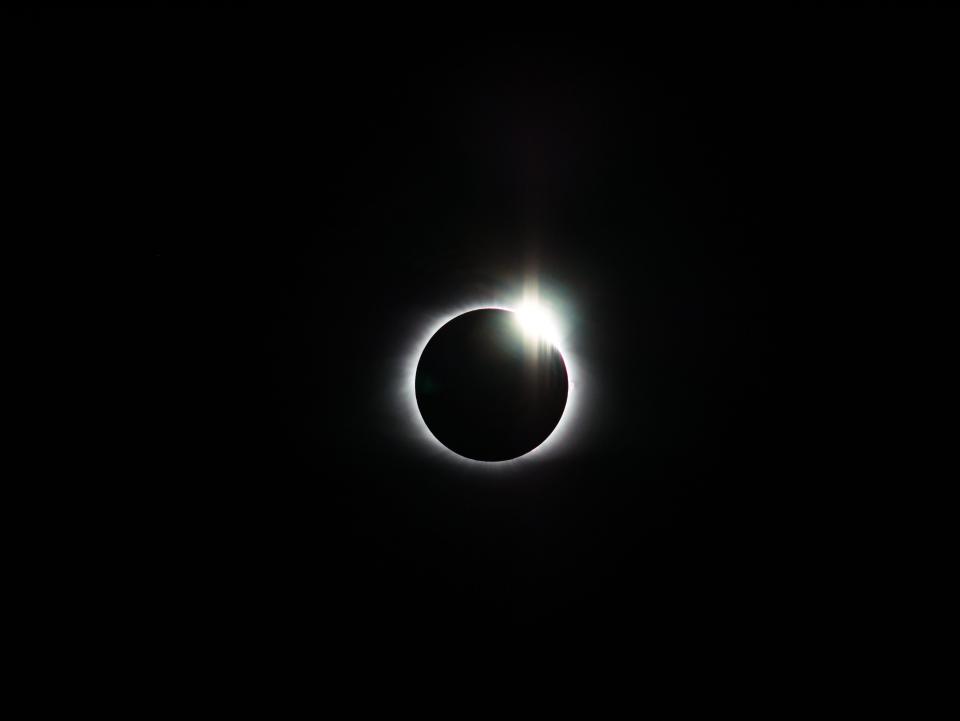When and where can I see the total solar eclipse? What to know about the path of totality
If you don't already live on the total solar eclipse's path of totality, you may want to make plans to get somewhere to catch a glimpse of the spectacular sight on April 8.
Not only is this the last time for 20 years that the moon's orbit will cause it to directly blot out the sun's disk anywhere in the United States, but we may never see an eclipse quite like this again in our lifetime.
The sun's outermost layer known as the corona will be brighter, the moon will appear larger, and the nighttime-like darkness known as totality will last just a bit longer than it did during the last North American total eclipse in 2017.
Here's a little bit about why the Great North American Eclipse of 2024 is so special, and when and where you can try to witness it.
When is the 2024 total solar eclipse? Your guide to glasses, forecast, where to watch.
Why makes this year's total solar eclipse different?

The last time North Americans witnessed a total solar eclipse in 2017, the sun's activity was at a minimum.
This time around, though, the sun will be at the peak activity of an 11-year solar cycle, making its elusive corona especially visible, astronomers say.
Meanwhile, the moon will be closer to Earth than it was seven years ago, making it appear larger in the sky and increasing the length that darkness will last in many places, according to eclipse2024.org.
This year's eclipse may also coincide with the passage of a 'devil comet' as the strange, recognizable object hurtles harmlessly overhead Earth.
Path of totality: Where to see the eclipse in the United States
The 115-mile-wide path of totality will pass over portions of Mexico and the United States, ending in Canada.
In the U.S. alone, hundreds of cities and smaller towns in 13 states lie along the path, providing a glimpse to an estimated 31 million Americans of a spectacular sight not often seen, according to eclipse cartographer Michael Zeiler at GreatAmericanEclipse.com.
Some of the major cities include:
Dallas and San Antonio, Texas
Little Rock, Arkansas
Indianapolis
Cleveland and Toledo, Ohio
Buffalo, Rochester and Syracuse, New York
Erie, Pennsylvania
Additionally, small parts of Tennessee and Michigan are also expected to experience the eclipse, NASA says. In the United States, the eclipse's path will end in Maine before visiting the maritime provinces of Canada, according to estimates.
What time will totality occur?
Mexico's Pacific coast will be the first location in continental North America to experience totality, which will occur at about 11:07 a.m. PDT, according to NASA.
As the moon's shadow travels northeast, totality in the U.S. will begin at 1:27 p.m. CDT in Eagle Pass, Texas. From there, the path will cut diagonally across the country before ending around 3:33 p.m. EDT in Lee, Maine, according to nationaleclipse.com.
Along the way, periods of darkness could last a mere few seconds or, in some cities, could surpass four minutes.
Here are the major cities in each state where you can expect to experience totality in the United States (note that the included times do not account for when the partial eclipse begins and ends):
Dallas, Texas: 1:40-1:44 p.m. CDT
Idabel, Oklahoma: 1:45-1:49 p.m. CDT
Little Rock, Arkansas: 1:51-1:54 p.m. CDT
Poplar Bluff, Missouri: 1:56-2:00 p.m. CDT
Paducah, Kentucky: 2-2:02 p.m. CDT
Carbondale, Illinois: 1:59-2:03 p.m. CDT
Evansville, Indiana: 2:02-2:05 p.m. CDT
Cleveland, Ohio: 3:13-3:17 p.m. EDT
Erie, Pennsylvania: 3:16-3:20 p.m. EDT
Buffalo, New York: 3:18-3:22 p.m. EDT
Burlington, Vermont: 3:26-3:29 p.m. EDT
Lancaster, New Hampshire: 3:27-3:30 p.m. EDT
Caribou, Maine: 3:32-3:34 p.m. EDT
If you want to see the time and duration for when totality would occur near each of these locations, see these interactive maps.
And if you plan on viewing the eclipse, just remember: Certified safety eyewear is a must until the moon completely blocks out the sun's light, leaving only the outermost layer visible.
Eric Lagatta covers breaking and trending news for USA TODAY. Reach him at [email protected]m
This article originally appeared on USA TODAY: Total solar eclipse is April 8: What to know about path of totality
